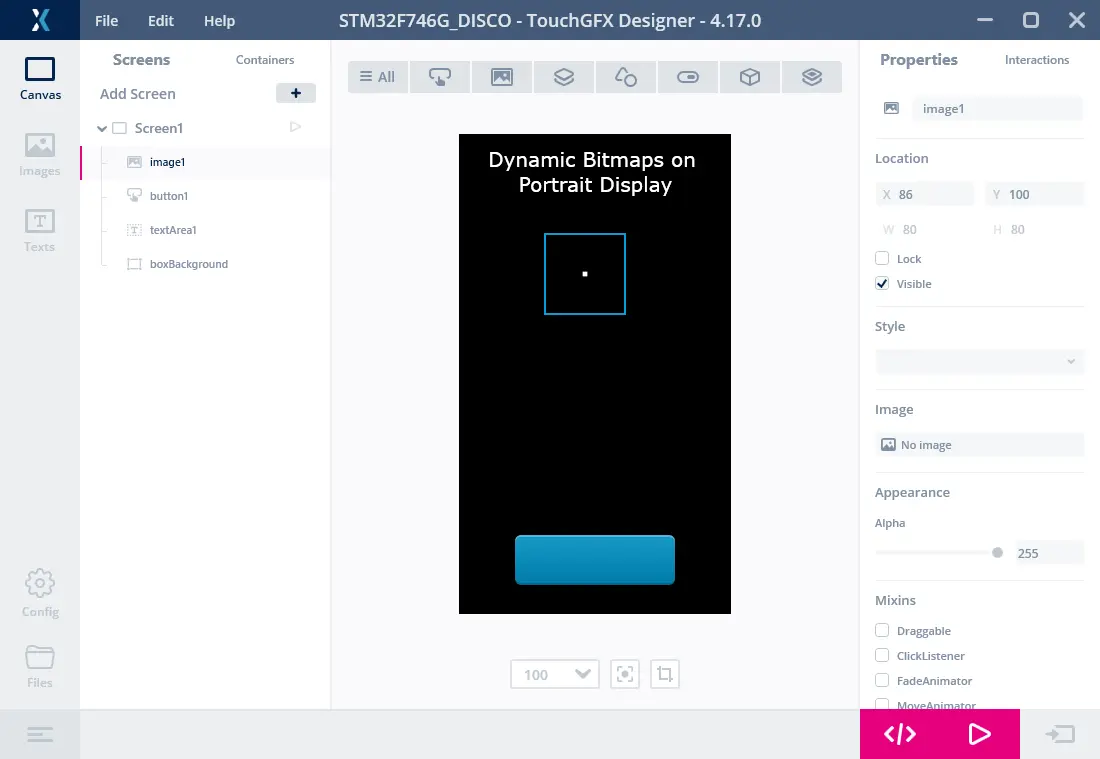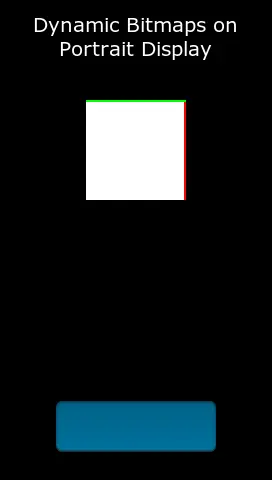动态位图
本节介绍如何使用动态位图。 注意,标准位图会被编译到应用中,因此必须在编译时提供。 位图从PNG等格式的文件转换而来,带有大小和格式信息并以内部格式保存。
此外,还可以在运行时间在RAM中创建位图。 这被称为动态位图。 动态位图的使用与编译到应用中的静态位图相同。 这意味着您可以通过图像和按钮等控件使用动态位图。
动态位图配置
在创建动态位图时,需要从位图缓存分配像素存储空间。 因此,您必须先配置位图缓存,然后才能创建动态位图。 这个过程不能在TouchGFX Designer或Generator中执行,需要手动执行。
参见关于位图缓存的文章获取配置过程。
必须定义应用中使用的动态位图的最大数量。 该最大值与位图缓存地址和大小一起传递到TouchGFX。 这里我们配置的是具有最多4张动态位图的位图缓存。 您可以在应用中的任何文件中执行。 如需只执行一次,文件FrontendApplication.cpp是个不错的选择:
FrontendApplication.cpp (extract)
#include <gui/common/FrontendApplication.hpp>
#include <touchgfx/Bitmap.hpp>
FrontendApplication::FrontendApplication(Model& m, FrontendHeap& heap)
: FrontendApplicationBase(m, heap)
{
// Place cache start address in SDRAM at address 0xC0008000;
uint16_t* const cacheStartAddr = (uint16_t*)0xC0008000;
const uint32_t cacheSize = 0x300000; //3 MB, as example
Bitmap::setCache(cacheStartAddr, cacheSize, 4);
}
如果您使用Windows模拟器,则还必须在此创建位图缓存。 在Windows上,可以容易的声明大阵列或使用malloc:
FrontendApplication.cpp (extract)
#include <gui/common/FrontendApplication.hpp>
#include <touchgfx/Bitmap.hpp>
FrontendApplication::FrontendApplication(Model& m, FrontendHeap& heap)
: FrontendApplicationBase(m, heap)
{
#ifdef SIMULATOR
const uint32_t cacheSize = 0x300000; //3 MB, as example
uint16_t* const cacheStartAddr = (uint16_t*)malloc(cacheSize);
Bitmap::setCache(cacheStartAddr, cacheSize, 4);
#else
// Place cache start address in SDRAM at address 0xC0008000;
uint16_t* const cacheStartAddr = (uint16_t*)0xC0008000;
const uint32_t cacheSize = 0x300000; //3 MB, as example
Bitmap::setCache(cacheStartAddr, cacheSize, 4);
#endif
}
使用动态位图示例
为了使用动态位图,我们需要一个控件来显示它。 为此,在视图(在代码中或Designer中)中插入一个图像控件:
#include <touchgfx/widgets/Image.hpp>
using namespace touchgfx;
class TemplateView : public View
{
private:
Image image;
}
此控件和动态位图的使用过程分为三步:
- 在位图缓存中创建动态位图
- 清空动态位图使用的存储空间
- 将位图分配给控件
在setupScreen中创建动态位图。 这里我们使用16bpp格式RGB565。 如果帧缓冲为24位,则使用RGB888。 如需创建透明位图,使用格式ARGB8888。
通过dynamicBitmapGetAddress函数返回动态位图中像素的地址:
#include <touchgfx/Bitmap.hpp>
void TemplateView::setupScreen()
{
BitmapId bmpId;
//Create (16bit) dynamic bitmap of size 100x150
const int width = 100;
const int height = 150;
bmpId = Bitmap::dynamicBitmapCreate(100, 150, Bitmap::RGB565);
//set all pixels white
if (bmpId != BITMAP_INVALID)
{
memset(Bitmap::dynamicBitmapGetAddress(bmpId), 0xFF, width*height*2);
}
//Make Image widget show the dynamic bitmap
image.setBitmap(Bitmap(bmpId));
//Position image and add to View
image.setXY(20, 20);
add(image);
...
}
您从位图缓存获得的像素存储空间未清空,建议立即将其清空或重写。
如需从文件加载图像,可以用loader代码替代对memset的调用。 请参考文章在运行时间加载图像
动态位图操作
动态位图操作全部位于Bitmap类中。
创建动态位图
以下方法用指定的宽度、高度和位图格式创建动态位图。 仅当有足够大的未使用存储空间时,才能创建位图。 如果未创建位图,该方法返回BITMAP_INVALID。
static BitmapId Bitmap::dynamicBitmapCreate(const uint16_t width, const uint16_t height, BitmapFormat format, ClutFormat clutFormat)
删除动态位图
此方法删除动态位图。
static bool Bitmap::dynamicBitmapDelete(BitmapId id)
获取动态位图中像素的地址
以下方法返回动态位图的地址。 文件加载器使用此方法将图像数据复制到位图中。
static uint8_t* dynamicBitmapGetAddress(BitmapId id)
设置动态位图的实心区域
以下方法设置动态位图的实心矩形。
static bool dynamicBitmapSetSolidRect(BitmapId id, const Rect& solidRect)
请阅读Custom Widget一节中关于“实心区域”概念的更多内容。
对于像RGB565和RGB888这样的非透明格式,将实心区域默认设置为整个位图。 对于像ARGB8888这样的透明格式,将实心区域设置为空。
竖屏模式的动态位图
TouchGFX能以竖屏模式运行。 这适用于显示屏自其原始方向旋转90度后安装的情况。 在该模式下使用动态位图时,需要格外小心。
下面是STM32F746的项目示例。 它的显示屏宽度为480像素,高度为272像素。 帧缓冲具有相同大小。
没有为image1图像控件分配位图。 我们将使用它显示动态位图。
在使用竖屏模式时,坐标系沿逆时针方向旋转90度。 (0, 0) 坐标位于“D”附近的左上角。 帧缓冲的第一个字节(将屏幕上第一个像素着色),位于右上角。
因此,当以竖屏模式运行时,不旋转帧缓冲。 对于动态位图也是如此。 但是,要在显示屏上第一行显示的像素必须绘制在帧缓冲的左边缘。
在下面的函数中创建动态位图,使上面一行为绿色且右边缘为红色:
Screen1View.cpp (extract)
void Screen1View::setupScreen()
{
Screen1ViewBase::setupScreen();
BitmapId bmpId;
bmpId = Bitmap::dynamicBitmapCreate(100, 100, Bitmap::RGB565);
if (bmpId != BITMAP_INVALID)
{
//set all pixels white
uint16_t* const bitmapPixels = (uint16_t*)Bitmap::dynamicBitmapGetAddress(bmpId);
memset(bitmapPixels, 0xFF, 100*100*2);
//first 200 pixels red, => two column on the right on display
for (int i = 0; i<200; i++) bitmapPixels[i] = 0xF800;
//first two pixels in all rows green in bitmap => top two rows on display
for (int i = 0; i<100; i++)
{
bitmapPixels[i*100] = 0x07E0;
bitmapPixels[i*100 + 1] = 0x07E0;
}
}
image1.setBitmap(bmpId);
}
显示屏显示动态位图:

